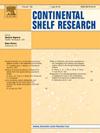Carbon fluxes in estuarine wetlands based on a material flow perspective
IF 2.2
3区 地球科学
Q2 OCEANOGRAPHY
引用次数: 0
Abstract
Estuarine wetland is important component of continental shelf and blue carbon system. The regulation and enhancement of the carbon pool in estuarine wetlands are contingent upon a clear understanding of the carbon cycle. Given that dynamic material flow is a landmark feature of estuarine wetlands, interpreting this process from a vertical and horizontal material flow perspective may offer a potential breakthrough. However, the impacts of the material exchange in estuaries on the key processes of carbon exchange in estuarine wetlands and the mechanism of carbon sink formation are not well understood. To accurately assess and predict the dynamic capacity of carbon pools in estuarine wetlands, this review summarizes the vertical carbon flux processes in estuarine wetlands, which are believed to be dominated by plant and soil material transport, as well as the horizontal carbon flux processes influenced by hydrological conditions. In addition, we discuss the impacts of carbon and nutrient fluxes from submarine groundwater discharge (SGD), which accompany estuarine wetlands, on the systematic carbon cycling. Finally, we offer a series of recommendations to bridge existing knowledge gaps and contribute to the broader scientific discourse on the carbon cycle in estuarine wetlands.

基于物质流视角的河口湿地碳通量研究
河口湿地是陆架和蓝碳系统的重要组成部分。河口湿地碳库的调控和增强有赖于对碳循环的清晰认识。鉴于动态物质流是河口湿地的一个标志性特征,从垂直和水平物质流的角度解释这一过程可能会提供一个潜在的突破。然而,河口物质交换对河口湿地碳交换关键过程的影响及碳汇形成机制尚不清楚。为了准确评估和预测河口湿地碳库的动态容量,本文综述了以植物和土壤物质运输为主导的河口湿地垂直碳通量过程,以及受水文条件影响的水平碳通量过程。此外,我们还讨论了伴随河口湿地的海底地下水排放(SGD)的碳通量和营养通量对系统碳循环的影响。最后,我们提出了一系列建议,以弥合现有的知识差距,并为河口湿地碳循环的更广泛的科学论述做出贡献。
本文章由计算机程序翻译,如有差异,请以英文原文为准。
求助全文
约1分钟内获得全文
求助全文
来源期刊

Continental Shelf Research
地学-海洋学
CiteScore
4.30
自引率
4.30%
发文量
136
审稿时长
6.1 months
期刊介绍:
Continental Shelf Research publishes articles dealing with the biological, chemical, geological and physical oceanography of the shallow marine environment, from coastal and estuarine waters out to the shelf break. The continental shelf is a critical environment within the land-ocean continuum, and many processes, functions and problems in the continental shelf are driven by terrestrial inputs transported through the rivers and estuaries to the coastal and continental shelf areas. Manuscripts that deal with these topics must make a clear link to the continental shelf. Examples of research areas include:
Physical sedimentology and geomorphology
Geochemistry of the coastal ocean (inorganic and organic)
Marine environment and anthropogenic effects
Interaction of physical dynamics with natural and manmade shoreline features
Benthic, phytoplankton and zooplankton ecology
Coastal water and sediment quality, and ecosystem health
Benthic-pelagic coupling (physical and biogeochemical)
Interactions between physical dynamics (waves, currents, mixing, etc.) and biogeochemical cycles
Estuarine, coastal and shelf sea modelling and process studies.
 求助内容:
求助内容: 应助结果提醒方式:
应助结果提醒方式:


